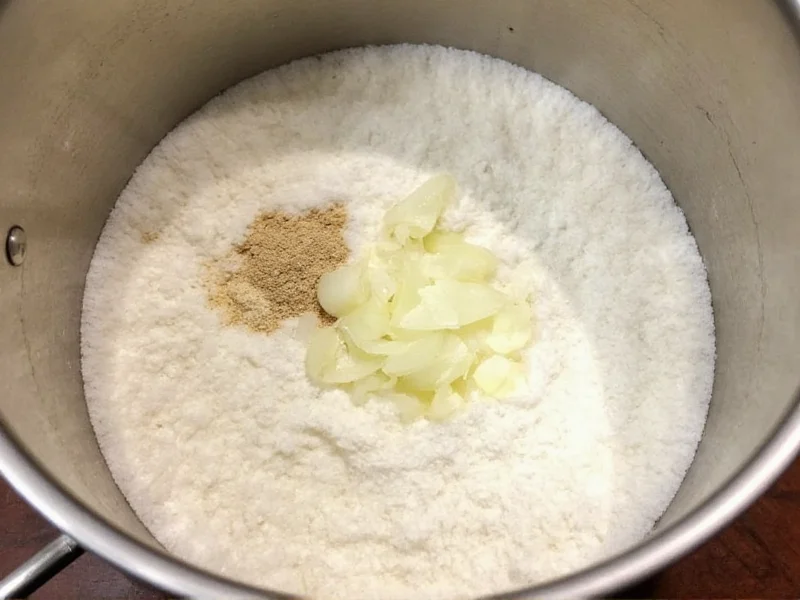Converting fresh onions to onion powder is essential when you're mid-recipe and discover you're out of fresh produce. Understanding the precise 1/4 cup onion to onion powder conversion prevents flavor imbalances that can ruin your dish. This measurement substitution follows a consistent 4:1 ratio - meaning every 1/4 cup fresh onion requires just 1 teaspoon of onion powder.
Understanding Onion Powder Substitution Ratios
When converting fresh onion measurements to dried onion powder, the water content difference creates the need for precise calculations. Fresh onions contain about 89% water, while onion powder is dehydrated to nearly 100% concentrated flavor. This fundamental difference explains why the volume decreases significantly during substitution.
Chef Marco Santos, who has developed recipes for major culinary publications, confirms: "The 4:1 ratio works consistently across most cooking applications. For every cup of fresh onion, use 4 tablespoons of powder. Scale down proportionally for smaller measurements like 1/4 cup."
| Fresh Onion Measurement | Onion Powder Equivalent | Best For |
|---|---|---|
| 1/4 cup chopped | 1 teaspoon | Sauces, dressings, marinades|
| 1/2 cup chopped | 2 teaspoons | Casseroles, soups, stews|
| 1 cup chopped | 1 tablespoon | Baking, dry rubs, spice blends|
| 1 1/2 cups chopped | 1 tablespoon + 1 teaspoon | Large batch cooking
Practical Application in Recipe Development
When substituting onion powder for fresh onion in recipes, consider these professional cooking techniques:
- Rehydration method: For dishes requiring moisture (like meatloaf), mix 1 teaspoon onion powder with 1 tablespoon water before adding
- Taste adjustment: Add powder gradually, tasting after each addition - dried spices intensify as dishes cook
- Timing matters: Add onion powder early in cooking for soups/stews to allow flavor dispersion, but later for sauces to prevent bitterness
- Flavor balancing: When using onion powder instead of fresh, reduce added salt by 15% since dehydrated forms concentrate sodium
Common Substitution Mistakes to Avoid
Many home cooks make critical errors when converting 1/4 cup fresh onion to dried onion powder. The most frequent mistake is using equal volumes (1:1 ratio), which creates overpowering onion flavor. Another common issue involves substituting onion flakes instead of powder without adjusting measurements - flakes require 1.5x more volume than powder for equivalent flavor.
Professional food scientist Dr. Elena Rodriguez explains: "Onion powder contains approximately 12 times more concentrated flavor compounds than fresh onion by weight. This scientific reality makes precise measurement non-negotiable in recipe development."
When Not to Substitute Onion Powder
While onion powder conversion for recipes works well in most applications, certain dishes require fresh onion for proper texture and moisture balance:
- Fresh salsas and relishes (texture is essential)
- Grilled or roasted vegetable medleys (fresh provides caramelization)
- Raw applications like salads or sandwiches
- Dishes where visual appeal matters (powder creates uniform color)
For baking applications like savory muffins or breads, the 1/4 cup to 1 teaspoon ratio works perfectly as the powder distributes evenly without creating wet spots that fresh onion would produce.
Storage Considerations for Onion Powder
Understanding proper storage extends your onion powder shelf life and maintains conversion accuracy. Store in an airtight container away from light and heat. Properly stored, onion powder retains optimal flavor for 2-3 years, compared to fresh onions which last 1-2 months in cool storage. After 18 months, you may need to increase powder measurements by 10-15% to achieve equivalent flavor intensity.











 浙公网安备
33010002000092号
浙公网安备
33010002000092号 浙B2-20120091-4
浙B2-20120091-4